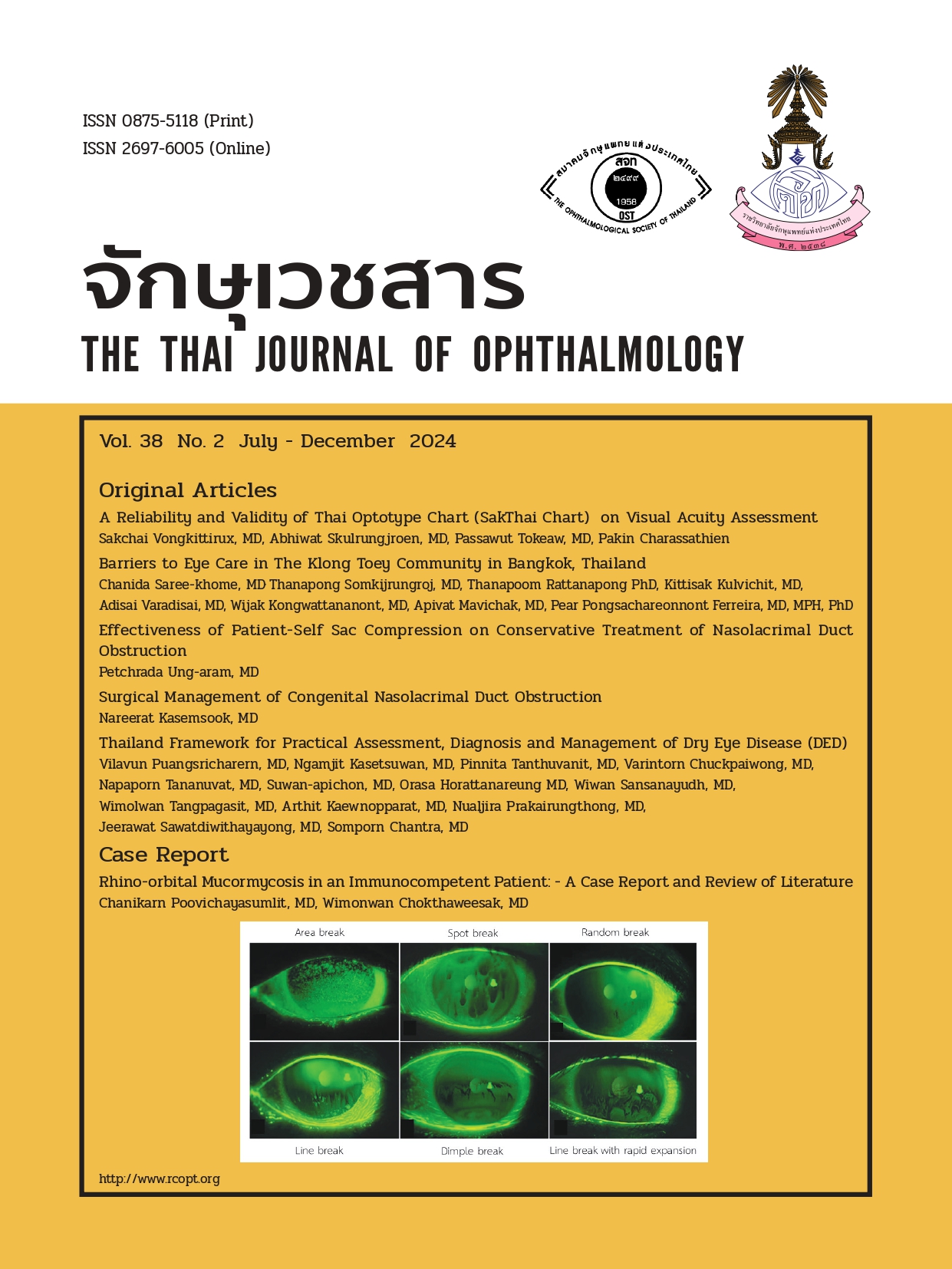การศึกษาประสิทธิภาพของการกดระบายถุงน้ำตาด้วยตนเองในการรักษาผู้ป่วยท่อน้ำตาอุดตัน
คำสำคัญ:
คำสำคัญ: ท่อน้ำตาอุดตัน, การกดระบายถุงน้ำตา, การรักษาเชิงอนุรักษ์บทคัดย่อ
การศึกษาประสิทธิภาพของการกดระบายถุงน้ำตาด้วยตนเองในการรักษาผู้ป่วยท่อน้ำตาอุดตัน
เพชรดา อึ้งอร่าม พบ.
บทคัดย่อ
วัตถุประสงค์: เพื่อศึกษาประสิทธิภาพของการกดระบายสิ่งคัดหลั่งในถุงน้ำตาด้วยตัวเอง ในด้านการลดอาการทางตา และการเพิ่มคุณภาพชีวิตของผู้ป่วยท่อน้ำตาอุดตันที่ยังไม่ได้รับการรักษาโดยการผ่าตัด
รูปแบบงานวิจัย: Prospective, non-randomized clinical trial
วิธีการศึกษา: รวบรวมผู้ป่วยท่อน้ำตาอุดตันที่มารับการรักษาที่โรงพยาบาลสมุทรปราการและรอรับการผ่าตัด สอนวิธีกดระบายสิ่งคัดหลั่งจากถุงน้ำตาให้กลับไปทำเองที่บ้าน ประเมินผลโดยเปรียบเทียบความสูงของชั้นน้ำตาและผลการทำแบบสอบถามคุณภาพชีวิต ก่อนและหลังการรักษา
ผลการศึกษา: จำนวนผู้ป่วยทั้งหมด 20 ราย 24 ตา เป็นชาย 1 ราย (5%) หญิง 19 ราย (95%) อายุเฉลี่ย 70.4+9.83 ปี ค่าเฉลี่ยของความสูงของชั้นน้ำตาในผู้ป่วยท่อน้ำตาอุดตันก่อนเข้ารับการรักษาคือ 0.41+0.12 มิลลิเมตร และเมื่อเปรียบเทียบก่อนและหลังเข้าร่วมวิจัยพบว่า ค่าความสูงของชั้นน้ำตาเฉลี่ยในผู้ป่วยทั้งหมดลดลงอย่างมีนัยสำคัญทางสถิติ จากกการทำแบบสอบถามคุณภาพชีวิต EQ-5D-5Q ค่าอรรถประโยชน์เฉลี่ยของผู้ป่วยท่อน้ำตาอุดตัน ก่อนเข้าร่วมวิจัย คือ 0.84+0.16 และเพิ่มขึ้นอย่างมีนัยสำคัญหลังเข้าร่วมวิจัย (0.94+0.07; P= 0.009 ) และ EQ-5D VAS scores ของผู้ป่วยที่น้ำตาอุดตันเฉลี่ยคือ 80.5+14.68 ซึ่งไม่พบความแตกต่างอย่างมีนัยสำคัญทางสถิติ เมื่อเปรียบเทียบก่อนและหลังเข้าร่วมวิจัย
สรุป: การแนะนำให้ผู้ป่วยกดหัวตาด้วยตัวเองที่บ้านเพื่อระบายสิ่งคัดหลั่งจากหัวตา สามารถช่วยลดอาการทางตาได้แก่อาการน้ำตาเอ่อ โดยมีค่าความสูงของชั้นน้ำตาที่ลดลง และช่วยเพิ่มคุณภาพชีวิตให้แก่ผู้ป่วยโรคท่อน้ำตาอุดตัน
References
เอกสารอ้างอิง
Dalgleish R. Incidence of idiopathic acquired obstructions in the lacrimal drainage apparatus. Brit. J. Ophthalmol 1964; 48:373.
Linberg JV, McCormick SA. Primary acquired nasolacrimal duct obstruction. A clinicopathologic report and biopsy technique. Ophthalmology 1986; 93:1055–1063.
Friedrich PP, Andreas BT, Steffen M, Bernhard NT. New insights into the pathophysiology of
primary acquired dacryostenosis. Ophthalmology 2001; 108(12):2329-2336.
Samuel WG. Etiology of dacryocystitis and epiphora. Arch Ophthalmol 1942; 27(1):167-188.
Pornpanich K, Luemsamran P, Leelaporn, et al. Microbiology of primary acquired nasolacrimal duct obstruction: simple epiphora, acute dacryocystitis, and chronic dacryocystitis. Clinical Ophthalmology 2016;10 :e337-e342.http://dx.doi.org/10.2147/OPTH.S100280
Huang J, Malek J, Chin D. Systematic review and meta-analysis on outcomes for endoscopic versus external dacryocystorhinostomy. Orbit 2014; 33(2): 81–90.
Alnawaiseh M, Mihailovic N, Wieneke AC, et al. Long-term outcomes of external dacryocystorhinostomy in the age of transcanalicular microendoscopic techniques. Journal of Ophthalmology 2016; Article ID 5918457. https://doi.org/10.1155/2016/5918457
Kuchar A, Steinkogler FJ. Antegrade balloon dilatation of nasolacrimal duct obstruction in adults. Br J Ophthalmol 2001; 85:200–204.
Lanciego C, Toledano N, Miguel SD, et al. Resolution of epiphora with nasolacrimal stents: results of long-term follow-up in a multicenter prospective study. J Vasc Interv Radiol 2003; 14:1417–1425.
Cinotti A, Siliquini J. Antihistaminic therapy of chronic dacryocystitis. American Journal of Ophthalmology 1966; 62(6):1116-1118.
Sanke RF. Pseudonasolacrimal duct obstruction caused by nasal allergy. Ophthalmic Surg 1989; 20:63–67.
Dayal Y. Coticosteroids and fibrolysin in the prevention of lacrimal duct obstruction.Br J Ophthalmol 1962; 46:27–30.
Xu J, Hong J, Sun X, et al. Combined lacrimal passage probing and tobramycin/dexamethasone ophthalmic ointment infiltration: a minimally invasive surgical procedure for incomplete nasolacrimal duct obstruction. Medicine 2015; 94: e1483. https://doi.org/10.1097/MD.0000000000001483
Yang MK, Kim N, Choung HK, et al. Effect of topical steroids on recently developed incomplete nasolacrimal duct obstruction: optical coherence tomography study. Graefes Arch Clin Exp Ophthalmol 2019. https://doi.org/10.1007/s00417-019-04392-1
Gohel DJ, Kumara M, Sokhal AK, et al. A Study Of Comparison Of Hydrostatic Regurgitation Test With Sac Syringing In Preoperative Cataract Patients. Int J Res Med 2016; 5(2);119-122.
Alam MS. The reliability of patient-reported mucoid reflux on nasolacrimal sac compression. Can J Ophthalmol 2019;54(2): e76-e77. https://doi.org/10.1016/j.jcjo.2018.06.004.
Wadgaonkar SP, Patil PA, Nikumbh DB, et al. Epidemiology of chronic dacryocystitis with special reference to socioeconomic status: A rural hospital study Indian Journal of Clinical and Experimental Ophthalmology 2016;2(1): 52-56. https :// doi: 10.7860/JCDR/2016/15365.7146.
Pattanaphesaj J. Health-related quality of life measure (EQ-5D-5L): measurement property testing and its preference-based score in Thai population [Doctoral dissertation]: Mahidol University; 2014.
Roh JH, Chi MJ. Efficacy of dye disappearance test and tear meniscus height in diagnosis and postoperative assessment of nasolacrimal duct obstruction. Acta Ophthalmol 2010; 88:e73–e77. https://doi.org/10.1111/j.1755-3768.2010.01873.x
Holly FJ. Physical chemistry of the normal and disordered tear film. Trans Ophthalmol Soc U K (1962). 1985;104 (Pt 4):374-80. PMID: 3862270.
Lim KJ & Lee JH. Tear meniscus height in dry eye syndrome. J Korean Ophthalmol Soc.1992;33: 29–31.
Savini G, Barboni P, Zanini M. Tear meniscus evaluation by optical coherence tomography. Ophthalmic Surg Lasers Imaging. 2006 Mar-Apr;37(2):112-8. PMID: 16583632.
Burkat CN, Lucarelli MJ. Tear meniscus level as an indicator of nasolacrimal obstruction. Ophthalmology. 2005 Feb;112(2):344-8. doi: 10.1016/j.ophtha.2004.07.030. PMID: 15691573.
Zhou T, Guan H, Wang L, et al. Health-Related Quality of Life in Patients with Different Diseases Measured With the EQ-5D-5L: A Systematic Review. Front Public Health. 2021 Jun 29;9:675523. doi: 10.3389/fpubh.2021.675523. PMID: 34268287; PMCID: PMC8275935.
Sothornwit J, Srisawasdi G, Suwannakin A, et al. Decreased health-related quality of life in patients with diabetic foot problems. Diabetes Metab Syndr Obes. 2018 Mar 7;11:35-43.doi:10.2147/DMSO.S154304. PMID: 29563821; PMCID: PMC5846758.
Tran BX, Ohinmaa A, Nguyen LT. Quality of life profile and psychometric properties of the EQ-5D-5L in HIV/AIDS patients. Health Qual Life Outcomes. 2012 Nov 1;10:132. doi: 10.1186/1477-7525-10-132. PMID: 23116130; PMCID: PMC3541089.
Chiowchanwisawakit P, Thaweeratthakul P, Wattanamongkolsil L, et al. Relationship between health-related quality of life and patient acceptable symptom state with disease activity and functional status in patients with ankylosing spondylitis in Thailand. J Clin Rheumatol. 2019 Jan;25(1):16-23. doi: 10.1097/RHU.0000000000000750. PMID: 29509563.
Xu RH, Cheung AWL, Wong ELY. The relationship between shared decision-making and health-related quality of life among patients in Hong Kong SAR, China. Int J Qual Health Care. 2017 Aug 1;29(4):534-540. doi: 10.1093/intqhc/mzx067. PMID: 28586442.
Van Duin MJ, Conde R, Wijnen B, et al. The impact of comorbidities on costs, utilities and health-related quality of life among HIV patients in a clinical setting in Bogotá. Expert Rev Pharmacoecon Outcomes Res. 2017 Jun;17(3):303-310. doi: 10.1080/14737167.2017.1246185. Epub 2016 Oct 25. PMID: 27730842.
Gray LA, Hernández Alava M, Wailoo AJ. Development of Methods for the Mapping of Utilities Using Mixture Models: Mapping the AQLQ-S to the EQ-5D-5L and the HUI3 in Patients with Asthma. Value Health. 2018 Jun;21(6):748-757. doi: 10.1016/j.jval.2017.09.017. Epub 2017 Dec 14. PMID: 29909881; PMCID: PMC6026598.
Downloads
เผยแพร่แล้ว
ฉบับ
บท
License
Copyright (c) 2025 จักษุเวชสาร

This work is licensed under a Creative Commons Attribution-NonCommercial-NoDerivatives 4.0 International License.
The Thai Journal of Ophthalmology (TJO) is a peer-reviewed, scientific journal published biannually for the Royal College of Ophthalmologists of Thailand. The objectives of the journal is to provide up to date scientific knowledge in the field of ophthalmology, provide ophthalmologists with continuing education, promote cooperation, and sharing of opinion among readers.
The copyright of the published article belongs to the Thai Journal of Ophthalmology. However the content, ideas and the opinions in the article are from the author(s). The editorial board does not have to agree with the authors’ ideas and opinions.
The authors or readers may contact the editorial board via email at admin@rcopt.org.


